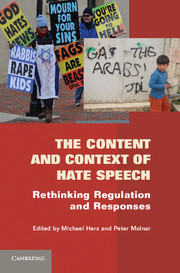Book contents
- Frontmatter
- Contents
- Contributors
- Foreword: Hate Speech and the Coming Death of the International Standard before It Was Born (Complaints of a Watchdog)
- Foreword: Hate Speech and Common Sense
- Acknowledgments
- Introduction
- Part I Overviews
- Part II Refinements and Distinctions
- Part III Equality and Fear
- Part IV International Law
- Index
- References
Introduction
Published online by Cambridge University Press: 05 June 2012
- Frontmatter
- Contents
- Contributors
- Foreword: Hate Speech and the Coming Death of the International Standard before It Was Born (Complaints of a Watchdog)
- Foreword: Hate Speech and Common Sense
- Acknowledgments
- Introduction
- Part I Overviews
- Part II Refinements and Distinctions
- Part III Equality and Fear
- Part IV International Law
- Index
- References
Summary
As we write this introduction, in early 2011, our home countries, Hungary and the United States, are both preoccupied (convulsed would be too strong a term) with concerns over appropriate limits on public discourse. On January 8, 2011, several people were killed and Congresswoman Gabrielle Giffords severely wounded by a gunman who opened fire on a crowd in Tucson, Arizona. That state has been riven by debates over immigration policy, gun control, abortion, and other divisive issues that have been at least sharp and often hostile and abusive. The shooting produced a great deal of soul-searching and hand-wringing over whether the corrosive terms and rhetoric of the political debate had produced such violence. There were many calls to tone down the rhetoric. At a memorial service, President Obama urged: “[A]t a time when our discourse has become so sharply polarized, at a time when we are far too eager to lay the blame for all that ails the world at the feet of those who happen to think differently than we do, it's important for us to pause for a moment and make sure that we are talking with each other in a way that heals, not in a way that wounds.” Yet it is not at all clear that the rhetoric, abhorrent as it often is, in fact produced this particular act of violence, and the rhetoric itself grows out of deeply held beliefs and is very well received by those who view the world the same way, so fundamental change seems unlikely.
- Type
- Chapter
- Information
- The Content and Context of Hate SpeechRethinking Regulation and Responses, pp. 1 - 8Publisher: Cambridge University PressPrint publication year: 2012
References
- 4
- Cited by

